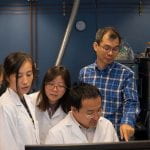Humanities “Works”: Connecting
with Industry and Enterprise
“Humanities Works” is one of eight “nodes” in the Penn State C3N initiative. C3N— Commonwealth Campus Community Nodes showcases collaborative faculty research across the 21 campuses. “Humanities Works” focuses on addressing complex problems through the collective work of PSU humanities scholars, with a special emphasis on four key areas: lifelong learning, education and new knowledge, civic and community engagement, and industry and enterprise. What role should the humanities play in business success? The PIs for “Humanities Works” are sharing their work with the goal of seeking success stories from faculty in the business sector.
–
This presentation is apart of the 2021-2022 COLLOQUIA SERIES
Webinar: Finding a connection between the brain and behavior: Contrast enhanced X-ray micro-CT as a tool for investigating neural plasticity in zebrafish
Cairsty DePasquale’s, associate professor of biology at Penn State Altoona, research focuses on understanding the roles the environment and physical activity play in mediating the connection between the brain and behavior in fish, primarily using zebrafish as a model organism. She is interested in understanding the impact of physical activity and the environment on fish behavior and the brain from an applied biomedical perspective, but also from an ecological multilevel perspective, spanning cellular and molecular organization to whole organism through to communities. Advancements in contrast enhancement of soft tissue for visualization using micro-computed tomography (micro-CT) have provided a novel and exciting alternative to view high-resolution structural information of the zebrafish brain.
–
This webinar is part of the Energy and the Environment Sustainability Laboratories’ 2021 Seminar Series
Webinar: Microplastics in freshwater wetlands: an intersection of soil science, geochemistry and hydrology
Lisa Emili, associate professor of physical geography and environmental studies at Penn State Altoona abstract: While plastic pollution in the marine environment is widely reported, significant plastic pollution in freshwater environments has only more recently been recognized. Despite the potential for wetlands to act as temporary and long-term reservoirs of microplastics (MP), MP cycling in wetlands, particularly as it relates to wetland soil remains largely understudied. An understanding of the spatial heterogeneity, mobility, and fate of MP in wetlands is needed to determine the potential for contaminant transport and new carbon sequestration. Studying MP cycling in wetlands requires the adaption and synthesis of methods originally developed for the analysis of marine surface waters and surficial sediments. This webinar will provide a discussion of: 1) the field and laboratory methods used to determine MP accumulation in soil, sediment, and water matrices from wetland study sites in Pennsylvania, 2) the extent of MP contamination in each matrix, and 3) the ongoing need to refine and standardize MP methodology.
This webinar is part of the Energy and the Environment Sustainability Laboratories’ 2021 Seminar Series
CCRCDP 20-21 Funding Program
The Commonwealth Campuses Research Collaboration Development Program (CCRCDP) launched its third year of funding.
All participating OSVPR Shared Core Facilities , as in prior years, will accept proposals on a rolling submission basis. All proposals must be submitted through Infoready (https://psu.infoready4.com/#competitionDetail/1834281).
University programs catalyze, advance research at Commonwealth Campuses
In an effort to catalyze and advance research at Penn State campuses throughout Pennsylvania, the University has developed two programs for faculty members at Commonwealth Campuses.
The programs, the Commonwealth Campuses Research Collaboration Development Program (CCRCDP) and the Commonwealth Campus Center Nodes (C3N) Program, offer faculty members at any Commonwealth Campus… Read More

